Shea Serrano is a New York Times best-selling author, a staff writer and podcast host at The Ringer, and the leader of a 257,000-person Twitter army. But before he became a beloved culture critic, Serrano was a middle school science teacher in Houston.
For our issue devoted to power, we worked with Serrano’s frequent collaborator, Dallas-based illustrator Arturo Torres, to create a comic about Serrano’s rise—and about how he leverages his huge Twitter following to support important causes, from homeowners recovering from Hurricane Harvey to a domestic abuse shelter. Read on for the full conversation with Serrano (who now lives in his native San Antonio) about why he tweets, how he brings the lessons he learned in the classroom online, and how he built the most earnest, supportive social media following on the internet.
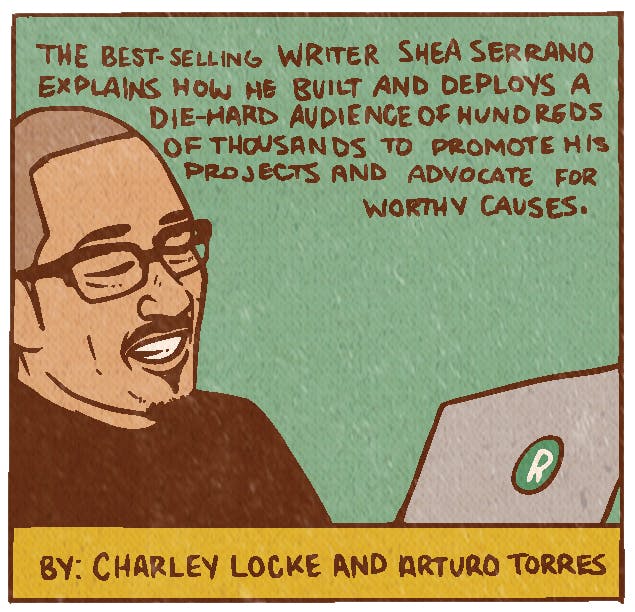
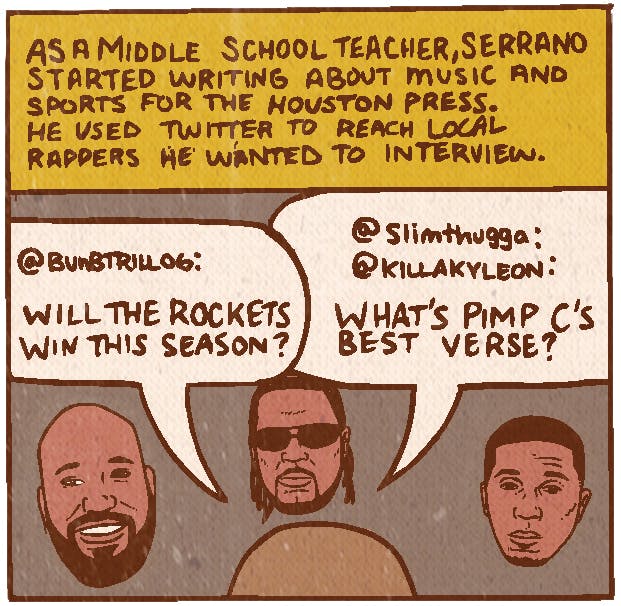
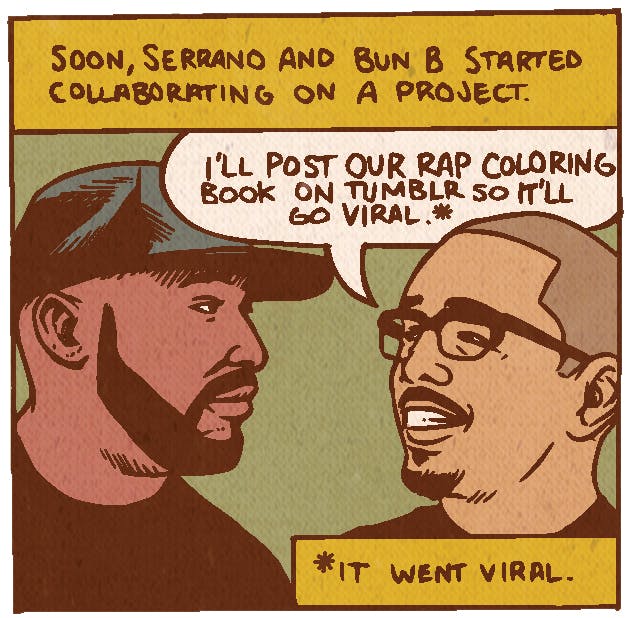

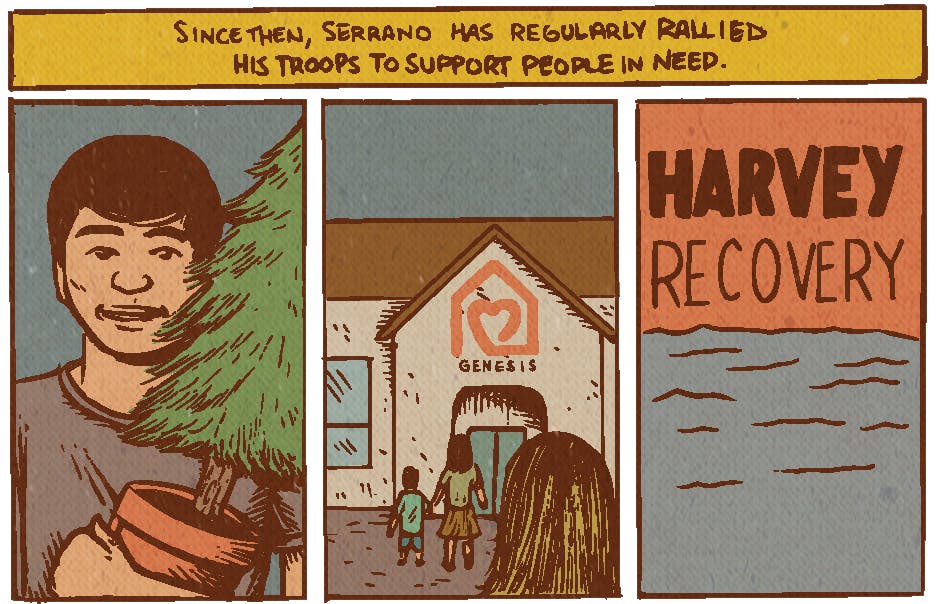
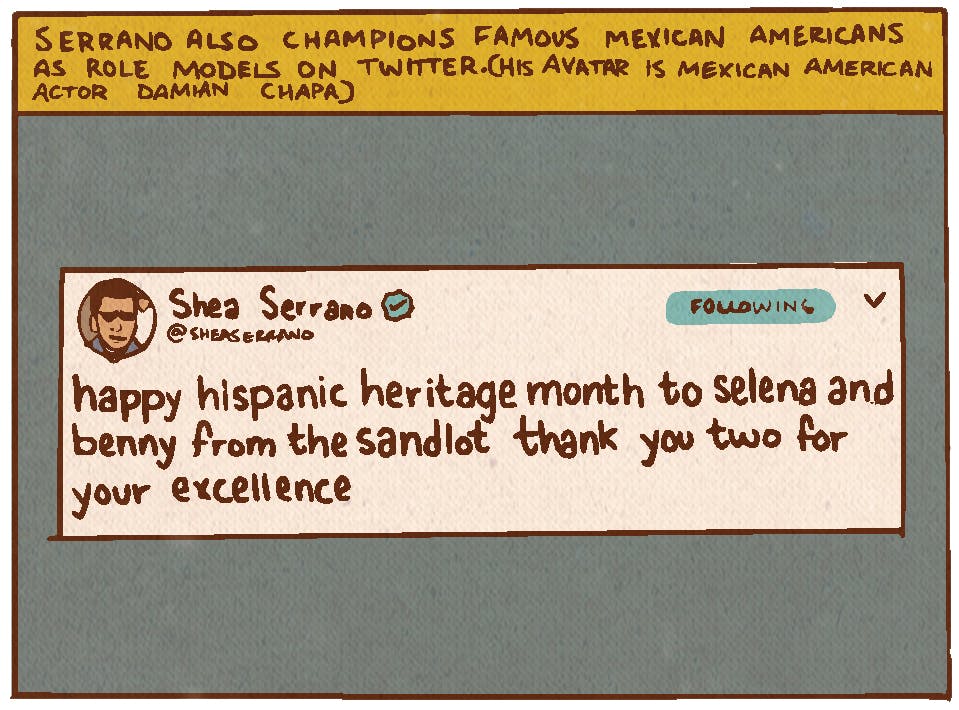
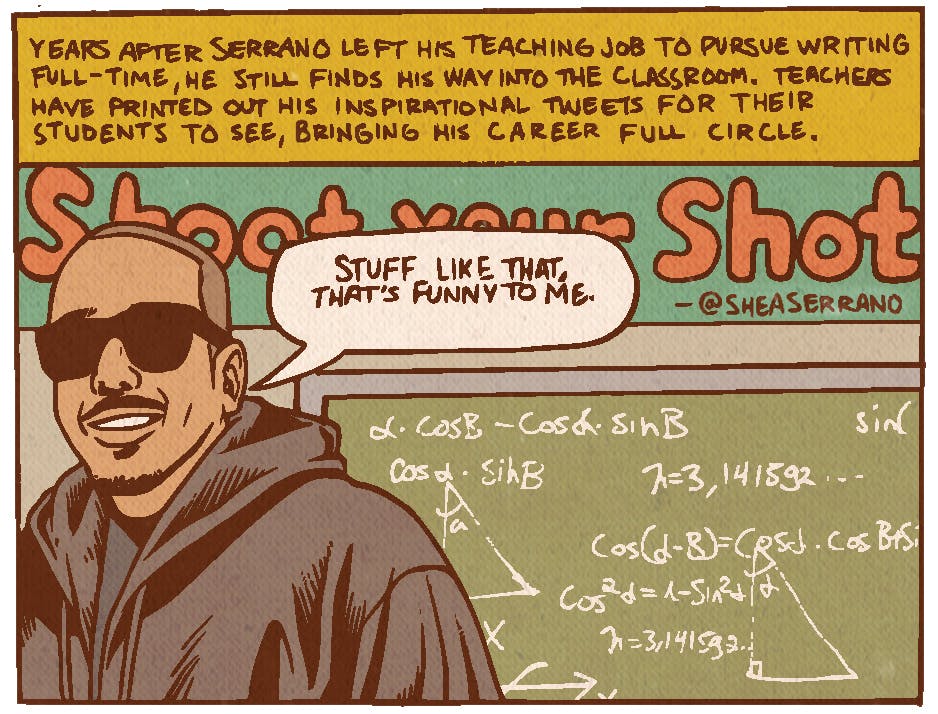
Texas Monthly: When did you first start using Twitter?
Shea Serrano: When I was freelancing at the Houston Press, the editor wanted me to ask rappers questions every week and put it together as a roundtable. It’s really hard to email or text or call a rapper, but for some reason, they were very responsive on Twitter. I could see Slim Thug or Bun B or Killa Kyleon talking to regular people on Twitter, so I was like, I’ll try it this way. And then I just started tagging them in tweets, asking them Houston-related things—what do you think is Pimp C’s best verse, or do the Rockets have a chance to win the finals this year—and sure enough, they responded. I would cobble those responses together and turn it into a weekly article that we would do. That’s how it started.
TM: You used commenting on articles to first get noticed by the editors at the Houston Press, right?
SS: Yeah, when I was trying to figure out how to get on the Houston Press, I read their website everyday trying to learn what kind of stuff they covered and who the people were. I figured anybody who was writing an article would probably take the time to read any comments on there, because there weren’t a lot of comments. So I just started leaving stuff on there. I would make sure to leave it under my name, and I would leave a comment that was at least a little bit insightful and thoughtful, to show that I read the article. I figured if I did that enough times, the editors would start to recognize my name, and they would be a little bit more likely to open my emails when I started emailing them or pitching them ideas. That was the plan. I don’t know if it worked or it didn’t work, because eventually I made friends with this guy named Matt Sonzala, who vouched for me at the Houston Press. It was a culmination of all that.
TM: How did you start collaborating with Bun B on the Coloring Book? Did you meet him on Twitter?
SS: No, I met him through covering rap for the Houston Press. I was going to all the shows, every weekend and all through the week. I’m hitting up all of these places, and Bun is very active. He’s very engaged in the rap community in Houston. He wants to show up and support people. It’s a big thing, if you’re an underground rapper and Bun B makes an appearance at your show in the crowd, and he’s doing that every single week. It was unbelievable. It didn’t matter how small of a concert it was that I went to, inevitably Bun B would show up for a few minutes and shake hands with a bunch of people, tell the rapper that was performing “great job,” and then get out. We met each other that way.
TM: So how did Bun B’s Rapper Coloring and Activity Book come together?
SS: One day, I had my phone off during school, and walking out of the building, I saw I had a voicemail from Bun B. I’m like, what the hell? I click play on it, and he’s like, “Hey Shea, it’s Bun. I think you and I should do a book together. Talk to your wife, see if it’s something you wanna do, and then call me back.” And that’s all that it was. I was like, oh shit, this is crazy—of course I want to do a book with fuckin’ Bun B, one of the most important figures in all of rap. So we had lunch one day: me, him, and his wife. We talked through some ideas that he had for a book and I countered with some ideas that I had. We just were shooting ideas back and forth via text for a couple months after that, and then the coloring book just sort of happened by accident. I didn’t think he was going to be into it at all, but he was super for it.
TM: How did social media play into the book coming together?
SS: That was the first time I realized how powerful social media was. After I pitched the idea to Bun and he agreed, I put together a proposal and started sending it to publishers. Everybody would either ignore me, or they’d be like, nah, this doesn’t sound like a good idea at all. I was like, all right, I’ve seen enough TV to know I need proof of concept if I want to sell a thing. I said, I’m gonna start a Tumblr, hopefully it’ll go viral, then I can show up to the publishers like, boom, look, people actually are interested in this. So I started Bun B’s rap coloring and activity Tumblr, and every few days, I would upload a new coloring page, with a link to download it for free and a link to a song from the artist. After a week, it went viral. It made it into New York Magazine‘s approval matrix and got a really favorable placement. Samantha Weiner from Abrams Publishing saw it and reached out to me, and that’s how we got the book deal.
TM: How did the FOH Army, your fanbase of Twitter followers, develop?
SS: That happened when the Rap Year Book came out. At the time, I had maybe 40,000 people following me. I was really pushing the book, trying to sell as many copies as I could the first week. As part of that, I was making a bunch of jokes with different bookstores—we’d sell out Amazon or Barnes & Noble or whatever. Somebody used the phrase, “It was like an army at this point.” Somebody else started calling it the “FOH Army,” because at the time, I was using the phrase “FOH” a lot. Just like anything else, once you give something a name, it becomes a thing that people can grab onto.
TM: When did you start using your Twitter presence to rally your followers towards a good cause?
SS: The first time was in the spring of 2016, for a women’s shelter in Dallas. After Grantland closed in October 2015, I didn’t have a job anymore, but because I was under contract, I was still getting paid until that following January. After a few months of doing nothing, I got bored, and I hit up Arturo [Torres, a Dallas-based illustrator and Serrano’s frequent collaborator]. I was like, let’s do a newsletter to practice writing and drawing some stuff. After a few weeks, it had 30,000 subscribers or so. I made a joke on Twitter one day about how I was paying $250 to $300 a month to send the newsletter out, and people started offering to send in a few dollars. I already had a job, so I didn’t need the money. But after four weeks of doing the newsletter, I told Arturo, “Hey, I’m gonna put a donation button in here, and we’ll just take this money and give it away to a place.” He was like, “All right, that works for me.” I didn’t tell anybody what we were doing, but I put the donation button in there, and it got a few thousand bucks. I gave a little bit to Arturo, as much as he would take, and then we sent something like $2500 to the Genesis Women’s Shelter. I posted screenshots on Twitter and I was like, here’s what we did, you guys donated to this place without knowing. That spread around and everybody was really excited about it. A few weeks later, we did another one, and it became a thing we were associated with, which is a cool reputation to have.
TM: Why do you think something like that is such an effective way to rally people together and raise money, for that and for causes like Hurricane Harvey relief?
SS: I think it’s just people wanting to be a part of a good thing. For the last one, I saw a news clip about how the food bank in San Antonio was running low on food, so one day I was just like, hey we’re all gonna donate here, so if you want to jump in, send the money to this place. We donated something like $10,000. I think people like to be a part of a big donation like that without having to give a lot of money. People always say I’ve donated $200,000 or whatever, but, I myself have probably donated $300 over the course of all of this, because everybody is just chipping in $5 or $10. It’s just cool to be like, oh, I helped with this.
TM: So much of your Twitter presence is about being genuine and about rooting for people, like your recent tweet about helping out aspiring writers. How much time do you spend replying to tweets and emails from people, paying it forward like that?
SS: It’s a substantial part of my day, for sure. It takes a while, but I mean, what else am I doing? I’m just sitting around writing stuff anyway.
TM: Does that kind of investing in people tie back to being a teacher for you?
SS: It definitely all ties back to being a teacher, even giving stuff names. That’s a trick you learn when you’re teaching: If you just give a group of kids a name or give a kid a nickname, things change. These are things I figured out when I was was teaching, things that make me feel good. I felt good all the time when I was teaching, because I knew I was helping kids. Every day, I could see the impact that I was having, even if it was a tiny thing. You don’t get to see that when you’re writing—I’m just staring at my computer all day long. So I think any little stuff that I can do probably helps me more than it helps other people. I don’t know, I’m always leery about trying to accept a bunch of credit for doing shit like that.
TM: What do you personally get out of Twitter now?
SS: For the most part, it’s just a way for me to connect with other people. The whole time we’ve been on the phone, nobody has been to my office. I’ve been in the office for two weeks now, and I had one visitor—my wife, because I asked her to come. Writing is a very lonely job. Twitter allows for me, for a few minutes, to not be alone.
TM: What are some of the most surreal interactions that you’ve had with people on Twitter?
SS: It’s always funny to me when people will incorporate stuff from Twitter into real life. I really like when teachers print out tweets and have them in their classrooms. That’s really charming and endearing to me.
TM: How much time do you spend on Twitter?
SS: If I’ve got a lot of stuff going on, then it’s not a great deal each day. The last couple days were really busy, so I probably sent five or six tweets during that time. But if there’s nothing going on, if I finish my work and I’ve got a day or two before I have anything else to do, I’m on there pretty much the whole day, just seeing what’s going on, trying to catch up on new stuff, or seeing what we’re all talking shit about today, what we’re feeling, just trying to keep tabs on everything.
TM: You’ve gotten political on Twitter, especially since Trump was elected—your campaign to get people to buy Why We March over The Art of the Deal on Amazon, and your more daily tweets about “fuck Trump.” Why do you take such a public political stance?
SS: Every time I say something like that, there’s definitely a group of people who say something like, “Why would you make me feel this way?” Without fail, it happens. That’s just the way it goes. But I feel like I have some responsibility. If people are following me on this thing, I should let them know how I feel. Let me be very clear about how I feel about immigration issues or pro-choice issues. Let me say as loud as I can, hey, I’m pro-choice, and I’m making this donation to Planned Parenthood, and if you don’t like it, cool, go somewhere else. It’s the same thing with Trump or with Ted Cruz or whatever. This is how I feel. If you like it, cool, we can hang out. If you don’t, there’s another place for you to hang out. You don’t have to be here.
TM: Did you ever anticipate introducing so many people on the internet to “Blood In Blood Out” [a movie still of actor Damian Chapa is Serrano’s Twitter avatar]?
SS: “Blood In Blood Out” is my favorite movie of all time, so I just like to talk about it. I do like when I get to tell people about this movie for the first time and then they go watch it and say how great it was. There aren’t a lot of Mexican heroes, and for me, Paco and Miklo and Cruz are heroes, minus all of the horrible things that they do. They’re pop culture heroes. I just like to celebrate stuff that I like.
- More About:
- Art
- Shea Serrano







